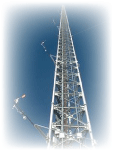Measurements at BAO Tower for the Carbon Tracker Observing Network
May 30, 2007
 The Earth System Research Laboratories (ESRL) has recently begun making
continuous measurements of atmospheric carbon dioxide and carbon monoxide
at the Boulder Atmospheric Observatory (BAO) 300m tower in Erie, CO. The
BAO site is the latest addition to ESRL's Carbon Tracker Observing Network.
Because of its proximity to the Denver metropolitan area, measurements from
the BAO tower will provide detailed information about urban and industrial
sources of CO2.
The Earth System Research Laboratories (ESRL) has recently begun making
continuous measurements of atmospheric carbon dioxide and carbon monoxide
at the Boulder Atmospheric Observatory (BAO) 300m tower in Erie, CO. The
BAO site is the latest addition to ESRL's Carbon Tracker Observing Network.
Because of its proximity to the Denver metropolitan area, measurements from
the BAO tower will provide detailed information about urban and industrial
sources of CO2.
Background:
ESRL's Global Monitoring Laboratory (GMD) began making measurements from tall
towers in the 1990s in order to extend long-term carbon-cycle gas
monitoring to continental areas. Existing television and radio towers are
utilized as sampling platforms for in-situ and flask sampling of CO2 and
other atmospheric trace gases. Carbon dioxide is the principal carbon
greenhouse gas, and measurements of its abundance are sensitive to upwind
fluxes including fossil fuel emissions and uptake and release by vegetation
and soils. Carbon monoxide is an indicator of combustion, and elevated
levels can result from urban or industrial emissions or from biomass
burning. CO data contribute to the interpretation of CO2 measurements by
helping to identify and quantify pollution episodes. GMD's tall tower sites
are principal components of ESRL's Carbon Tracker Observing Network.
The BAO tower has been operated by the ESRL Physical Sciences Laboratory (PSL) since the 1970s and serves as a unique facility for monitoring the Earth's atmospheric boundary layer. In addition to the new BAO site, the network includes three other tall tower sites, and plans call for the addition of eight more towers distributed throughout the continental US over the next several years.
Significance:
Data collected from the BAO tower will contribute to the North American
Carbon Program, a multi-agency effort to improve understanding of the
carbon cycle. The data represent an important new constraint for ESRL's
Carbon Tracker CO2 assimilation system and will improve
NOAA's ability to reliably estimate surface sources and sinks of CO2. Detailed
knowledge about the carbon cycle is essential for understanding and predicting
global climate change. These activities advance NOAA's mission goal of
understanding climate variability and change in order to enhance society's
ability to plan and respond.
| Contact: Dan Wolfe |